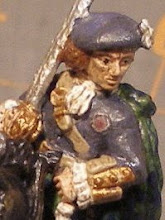It has been a long time since I made a naval post here. Lately the Jackson Gamers have been assisting David Manley and Stuart Machin of Long Face Games in play testing their latest naval rules. They have developed "Si Vis Pacem" for quick play WW1 naval gaming, subtitling it "How you can play Jutland in a day."
Here is a report on our final play testing with a brief description of the action, some pictures, and a few comments about the rules.
We used Lord Sterling's 1:6000 scale WW1 ships, which are based on the "Jutland" board game counters. If you'll remember, we used them back in 2016 to do a re-enactment of Jutland, using Avalon Hill's "Jutland" rules.
Battle
Description
Based
on the situation of 31 May 1916 (first day of Jutland), the British
battlecruiser squadrons, reinforced by the 5th Battle Squadron, are out hunting for Germans. And the Germans are there, but more
than VAdm Beatty was led to believe. VAdm Scheer and VAdm Hipper had
planned a surprise consolidating the 1st Scouting Group with the 3rd
Battle Squadron. The British had 4 super-dreadnoughts and 6
battlecruisers versus the Germans 8 super-dreadnoughts and 5
battlecruisers.
As the
opponents spotted each other at 26,000 yards, each force immediately
started closing. Soon large caliber shells were raining down on the
"steel castles." But the lighter British battlecruisers
were at a disadvantage, soon sustaining heavy damage to all and
having two blown apart. But the Germans didn't escape unscathed,
having several ships sustain heavy damage and several more medium
damage. The British battleships also sustained some damage to all
four.
Smoke
sighted on the horizon behind both fleets had the commanders looking
over their shoulders wondering if it was friends or more foes. The
three battle squadrons of the British Home Fleet were advancing in a
long line from the northeast while the British 3rd Battlecruiser, 1st
Cruiser, and 2nd Cruiser Squadrons were approaching from the
northeast. The lead British battleships (2nd Battle Squadron) soon
made their impact felt by firing on the German 6th Division/3rd
Battle Squadron, which included SMS Friedrich der Grosse,
Scheer's flagship. Knowing that his fleet was now outnumbered, Scheer
decided to call it a day. He had destroyed two British
battlecruisers and heavily damaged four more, plus damaged four
British battleships. He had averted the Kaiser's displeasure by not
loosing any ships, only having four battleships and one battlecruiser
damaged.
Photographs (from a high flying Zeppelin)
With the 1st Scouting Group in the
lead, the German 5th and 6th Battle Squadrons sail towards the
southeast, hoping to lead the lead the British into an ambush.
The British Battle Cruiser Fleet with
1st Battlecruiser Squadron, 5th Battle Squadron, and
HMS Lion (fleet flag) and 2nd Battlecruiser Squadron advance towards the Germans. All of a sudden Beatty realized, "By
Neptune's beard, those are battleships!"
Later in the action the German 6th Battle Division
turns towards the approaching British battleships, the 5th Battle
Division and the battlecruisers try to get around the rear of their
British opponents. In the background, the British 1st Battlecruiser
Squadron has had one ship heavily damaged, leaving the line, while
the same has happened to HMS Lion (Beatty's flag ship) in the
foreground. In the far background the British Home Fleet sails
closer, with the lead, HMS George V, sustaining medium damage which
she returned in kind on the SMS Friedrich der Grosse (Scheer's flag ship).
The red puffs indicate heavy damage,
the black medium damage, and the white light damage.
Now a third British battlecruiser
sustains heavy damage and withdraws while the remaining three have
medium damage. The two lead British battleships of 5th Battle
Squadron (center) have sustained medium damage. Three German
battleships and one battle cruiser have suffered medium damage and
one battlecruiser has suffered light damage. The German 1st Battle
Squadron is approaching from off the picture to the right.
With HMS Lion and the two
battlecruisers of 2nd Battlecruiser Squadron heavily damaged and
fleeing the area, the British battleships attempt to screen them from
fire from the German battleships. On the top, one of the 1st
Battlecruiser Squadron ships is also fleeing.
When your defense factor is a one and
you roll a one under fire from a German battleship who has crossed
your T, just about any German roll will result in destruction. Here
HMS Queen Mary blows up as the heavily damaged HMS Princess
Royal flees.
Final shot of the battlefield when VAdm
Scheer made his decision to withdraw and declare victory. With 16
battleships of the Home Fleet closing, Scheer really had no other
choice.
Comments on the Rules
"Si Vis Pacem" is a quick playing rule set that is both simple and complex. It is easy to pick up on the rule basics and a player can function without too much guidance after the first round of firing. Who moves first or second is decided by the side with the initiative while firing is done sequentially with the player having initiative firing a unit of ships first, then the second player firing, then back to the first player. Torpedo attacks are done the same way after all gunfire which allows ships being attacked to fire at their attackers, potentially driving them away.
There are advanced rules and campaign rules we didn't try, just concentrating on the basics. The advanced rules add some additional flavor and complexity to the basics, but not enough to take away from the playability of the rules. Based on what I've read in David Manley's pre-dreadnought "Broadside and Salvo," the campaign rules will allow one to fight their own actions in the North Sea between the British Home Fleet and the German High Seas Fleet.
We are looking forward to the release of "Si Vis Pacem" later this spring and to more WW1 naval games in the future.




























